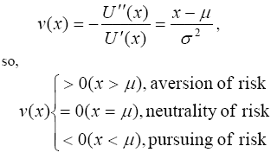Here, the rule that we obey is: an APL and a RL constitute a decision. If RL is lower than APL, the result of decision making is of loss; if RL is higher than APL, the result of decision making is of profit. This is applicable to circumstance that RL is hoped to run high.
A. The Prospect Utility Function
Definition 3 If RL follows the partial distribution, i.e. the X εP( µ, σ2), X is the variable of RL, for any xε[0,∞), we call
 (6)
(6)
the profiting utility function of a prospect, where, x means a sample value of RL. And call
 (7)
(7)
the losing utility function of a prospect. The Profiting utility (6) can be comprehended as satisfying degree at the same time, and losing utility can also be comprehended as desponding degree. The U(x), profiting utility function, is also called PD-utility function.
From Definition 3, we will see as follows:
1) A lower APL is easy to be satisfied, and a higher APL is easy to cause a disappointment.
2) The higher the x (RL) is, the higher the satisfying utility is; and the lower the x (RL) is, the higher the desponding utility is.
3) If µ and σ are separately different, the same x will cause the different satisfying utility U(x) and the different desponding utility U(X).
4) The probability of an prospect being realized, i.e. the probability of getting profiting, is
 (8)
(8)
5) The probability of an prospect not being realized, i.e. the losing probability, is
 (9)
(9)
B. Analysis of Risk Preference
According to the theory of risk preference and (6), we have
 (10)
(10)
The equation (10) can be explained for: in general, when RL is higher than APL, person is aversed by the risk; when the RL is equal to APL, person is neutral to the risk; when RL is lower than APL, person pursues the risk. This kind of condition is marked in the stock market. For example, one is tend to sell the stock when his stock is in an accrual; One is tend to do nothing when his stock price is equal to the current price in the market; one is tend to hold the stocks or buy stocks more at the lower prices when his stock is in a losing.
Prof. Feng Dai, Prof. Song-tao Wu, Prof. Ya-jun Zhuang
Next: Analysis of Pd-Utility Function Characteristics
Summary: Index